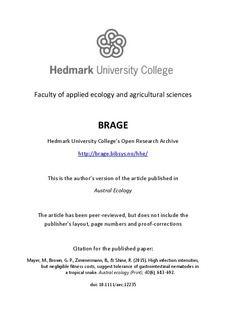High infection intensities, but negligible fitness costs, suggest tolerance of gastrointestinal nematodes in a tropical snake
Originalversjon
Mayer, M., Brown, G. P., Zimmermann, B., & Shine, R. (2015). High infection intensities, but negligible fitness costs, suggest tolerance of gastrointestinal nematodes in a tropical snake. Austral ecology, 40(6), 683-692. 10.1111/aec.12235Sammendrag
We investigated patterns of prevalence and intensity of gastrointestinal nematode infections in a tropical natricine snake, the keelback (Tropidonophis mairii). Ninety-eight per cent of keelbacks were infected with Tanqua anomala (Gnathostomidae), with infection intensities of up to 243 worms per snake. Infection with T. anomala caused severe inflammation of stomach mucosa and submucosa at the sites of parasite attachment and encystment. Nonetheless, we did not detect detrimental effects of nematode infection on measures of fitness among wild or captive snakes. Snakes with heavier nematode infections had higher body condition scores than less-infected individuals. Deworming captive snakes had no measurable effect on their growth rate, body condition or locomotor performance. In combination with an earlier study on blood-dwelling hepatozoons, our work suggests that keelbacks have a high tolerance to parasites. The ‘fast-pace’ life history and short lifespan of these snakes may make it beneficial for them to tolerate infection, rather than expend energy on resisting parasite attack.
